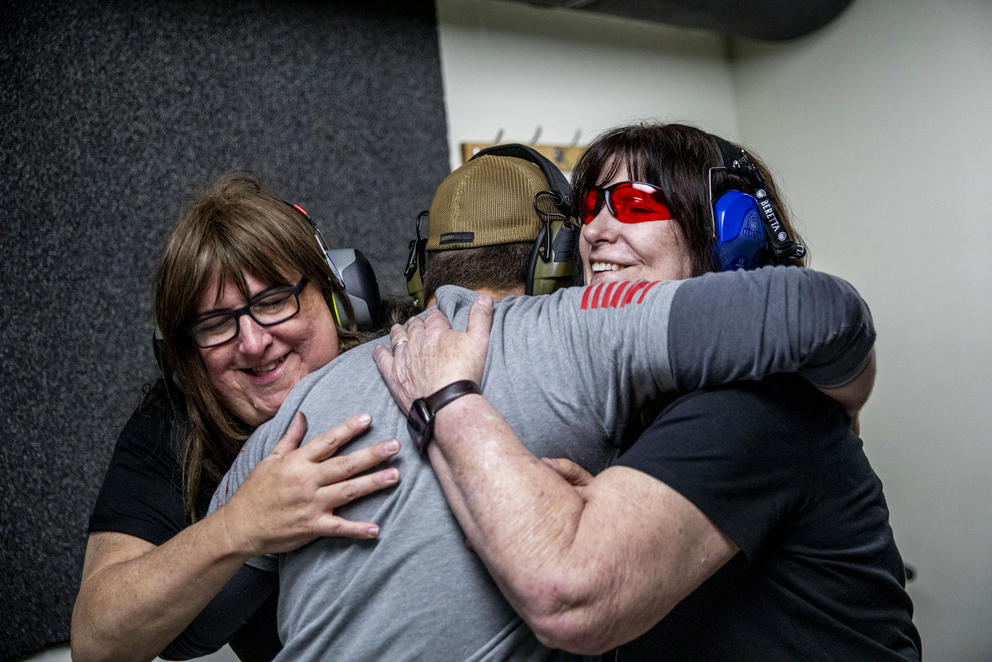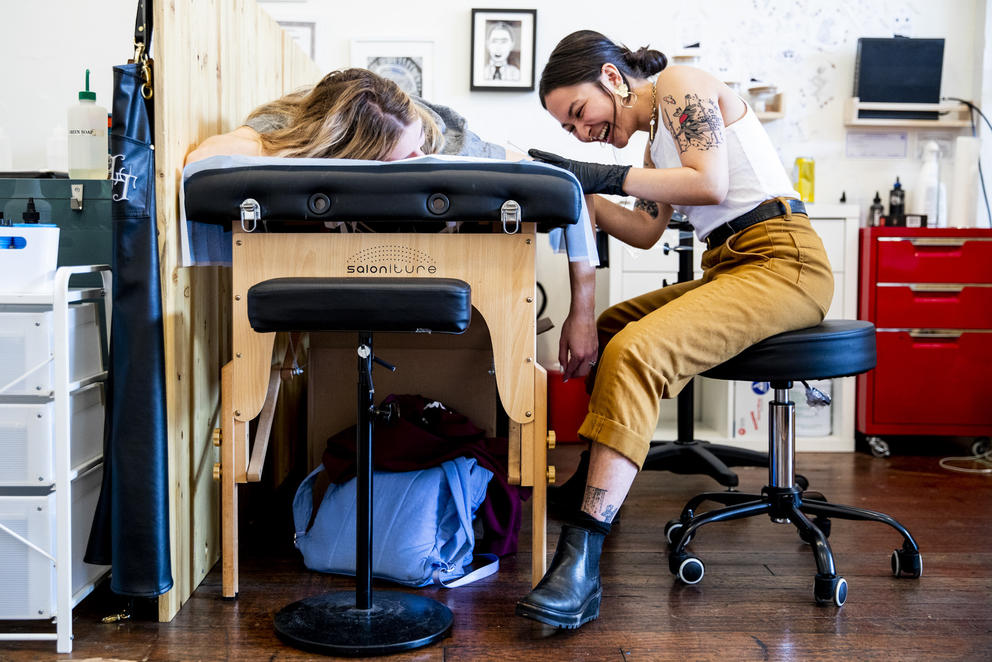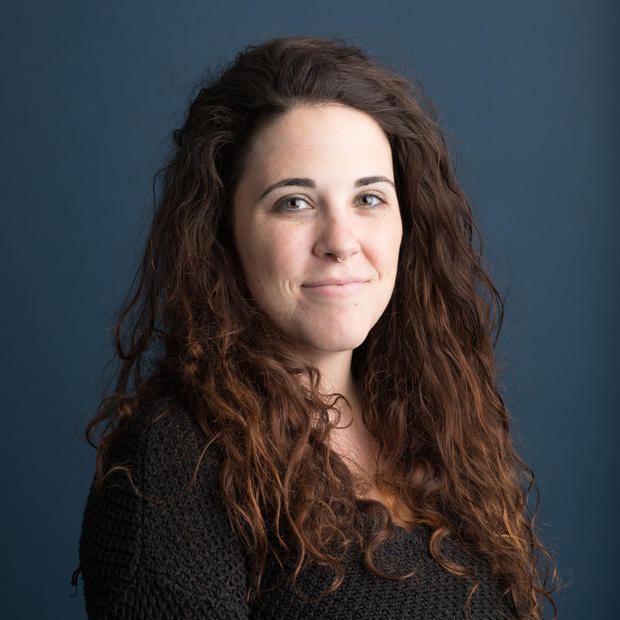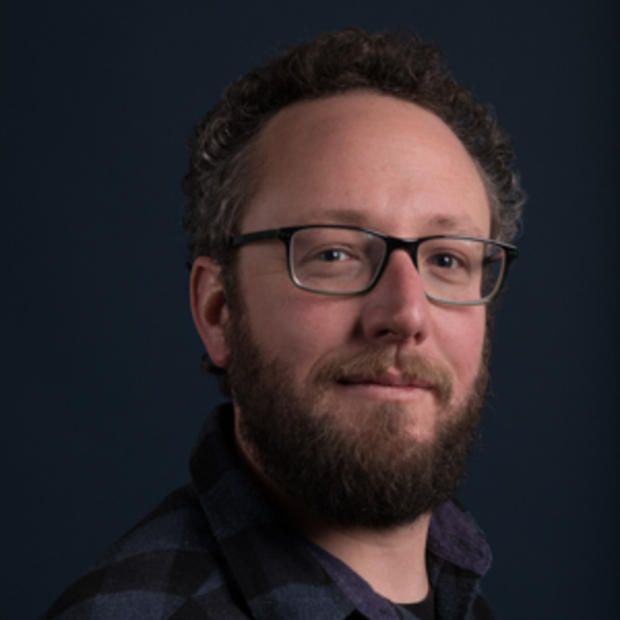Dan Ayres is nicknamed the “razor clam guy.” Razor-clam digging has been a part of his family for generations, and he is now the coastal shellfish manager of the Washington Department of Fish and Wildlife. His passion for making sure families have access to this treasured tradition comes through in everything he does. I wrote about Ayres’ family history with razor clamming on the Washington coast and what keeps him motivated. This photo, though not of Ayres himself, exemplifies everything he is trying to protect: families razor clamming together.
–Dorothy Edwards
Finding interesting ways to tell stories that might not be visual is always a fun challenge. Josh Cohen, a former colleague who was Crosscut's regional growth reporter,was working on a story in January about city workers getting flexible scheduling when the Alaskan Way Viaduct closed, creating traffic and transit problems across the city. That's when the idea popped into my head of incorporating both Seattle City Hall and the soon-to-be-demolished viaduct in the same photograph, using the double-exposure functionality in my camera. So I wandered around the lobby at City Hall on a late winter afternoon, searching for some nice light and compositional elements. Once I made the image I felt would partner well with a subsequent frame of the viaduct, I tucked my camera away in my bag and hurried through the city on foot, to a space I had previously explored and hoped would work. I pulled my camera out again, made some manual exposure adjustments and then snapped the second half of this in-camera double exposure.
–Matt M. McKnight
Sometimes an editor sends you an assignment request, and you immediately see a special story waiting within. "The Art of Alzheimer's: The Artist Within" was on exhibition this past January at Seattle City Hall, and I felt like a deeper look at one of the artists would help better tell the story of the exhibition and the life of those who are living with dementia. While spending time with Rafe Schwimmer and his wife, Paula, he took a break from creating his art, and they began to dance together in their Shoreline home to an old Hank Williams record playing loudly on a turntable. "He liked to dance with me before, but more so now because his inhibitions are less than they used to be," she said, with a slight chuckle. Once a week the couple take dance classes together, with help from Momentia, a grassroots organization devoted to keeping those living with dementia active and engaged in the community.
–Matt M. McKnight
Action sports photography has never been my forte, but when it melds with rural culture, I'm always driven to experience it. I traveled to rural Conconully for a couple of days during January to figure out what exactly drives people to attach skis to an outhouse and race it together down a snowy one-street town. Team Krap-N-Ator navigated a hay bail obstacle course during a heat of the Outhouse Races on Jan. 19, 2019. More than 2,000 spectators turned out for this year's event, with 15 outhouses competing in 10 different race categories.
–Matt M. McKnight
I photographed Tom Hansen, the Seattle author of American Junkie, at Beth's Cafe in Seattle on Jan. 30. When I walked into Beth’s Cafe for the first time to meet Hansen, I fell in love with the place — those hand-colored pictures on the walls! The cozy, welcoming feel of the diner made getting to know the people sharing a booth with you feel natural. You feel at home. Making his photo in this diner, which has been around since the ’50s, felt really special. It felt like a reminder that, as cities grow and change, there aren’t a lot of spaces like this left in Seattle.
–Dorothy Edwards
When the nearly two-week-long "snowpocalypse" started in Seattle in February, I happily braved the elements to make photographs of the city. The Alaska Way Viaduct had just closed forever to vehicle traffic, and the $3.3 billion, 2-mile-long replacement tunnel opened as scheduled. As I approached the overlook at Pike Place Market, I noticed a lone man walking across the top span of the now nonexistent structure. This particular image struck me as historic in many ways; a unique sight of no cars driving on the viaduct, but a pedestrian walking by, and rare snow blanketing the city.
–Matt M. McKnight
This year Seattle’s Pacific Northwest Ballet started its first-ever women-only choreography class, called "New Voices: Choreography and Process for Young Women in Dance,” with hopes of addressing gender disparity in choreography. Most professional choreographers in the contemporary ballet world are men. I spent the evening of Feb. 6 with Eva Stone’s class and got to see young women work through movement studies and create dance combinations with each other. I watched these young women feel empowered to create and got a sense of hope that we could see a real change in the choreography field in the near future.
–Dorothy Edwards
Fai Mathews, longtime Seattle resident and veteran delivery driver for Meals on Wheels, wasn't deterred by the unexpected heavy snow that Seattle experienced this past February. She and other drivers were out in the snow, ice and slush delivering meals to elderly and disabled clients who hadn't been able to leave the house during the two-week period that shut down most of the city. Reporter David Kroman and I witnessed Fai get stuck on multiple occasions while we tagged along on her route in North Seattle. She persisted, and at times other community members would stop what they were doing to help her. I was in total awe of how driven she and others were to help each other during that time. Apparently, a historic snowstorm can break down that notorious Seattle Freeze.
–Matt M. McKnight
Jennifer McSherry lost her partner, Derek Hutchinson, in September 2017 while he was a King County inmate and his complaints of pain went unanswered. As she went through some of Hutchinson’s belongings in her apartment on March 6, she was very open with me about the grief she was still experiencing. In this particular moment, she came across his old belt in a drawer and was overcome with emotion. McSherry started working with public defender Corey Guilmette to demand an inquest into the death of her partner of 15 years. Her bravery in facing the pain in order to get the answers and justice she deserves will forever deeply impact me, and I hope others as well.
–Dorothy Edwards
My heart was broken with the Muslim community worldwide on this March day. Worshippers gathered during an afternoon Jumu’ah service at Plymouth Congregational Church in downtown Seattle, which shared the space with the Muslim community as they grieved the loss of 50 people killed during a terrorist attack in New Zealand. Colleague Lilly Fowler and I quietly witnessed these somber moments together as we reported on a story about local reaction to the attack on March 15.
–Matt M. McKnight
Working on a story with arts and culture writer Margo Vansynghel, I met Eva and Cedric Walker of The Black Tones while at their band's practice session. After talking for a few minutes, we realized that we lived relatively close to each other, and that they were born and raised in the south end. Because their music draws in part from their childhood, I wanted to create some playful portraits that included some of the spaces they frequented as kids. After some collaborative conversation, we arrived at Rainier Playfield in Seattle's Columbia City neighborhood, where they both currently live.
–Matt M. McKnight
Icel Sukovaty, front left, and Sally Thornton-White, right, led the Methow Valley Climate March through downtown Twisp on April 19. Living in the Methow Valley, where wildfires have become more common, they have directly felt the effects of climate change. Thornton-White says the ever-present possibility of evacuation is a big part of what motivates her activism. "We lived with fires and flooding and things that have been ravaging our homes and we've gotten used to this," Sukovaty says. This photo, to me, is a reminder that the young people are the ones leading this cause and fighting for their future — and asking us to join them.
–Dorothy Edwards
When I met acclaimed comic book artist Simon Hanselmann at his home on Beacon Hill in Seattle in April, he didn't seem quite prepared for his day and what he expected to be a portrait session. "You can just wait for me in the living room and I'll be out in a few minutes," Hanselmann said. I asked if I could photograph him while he was getting ready as well, and he agreed. When I entered his bathroom I learned that he was changing into a dress and putting on his wig — an ensemble that helps him identify with the cartoon character he's become well-known for creating. This particular image always reminds me that there's always something more interesting happening just around the corner, all we need to do is search for it.
–Matt M. McKnight
Eighth-grader Brooke Benson is a member of Nerdy Girls, an underground robot society in Ellensburg that teaches young girls robotics. I spent some time getting to know members of Nerdy Girls, including its founders, Parker and Greta Mayer. The sisters had some negative experiences when they first jumped into the world of competitive robotics, being told that differences in biological hardwiring were to blame for the lack of girls building and programming robots. Parker and Greta rejected that thinking and wanted to create a safe space for young girls and members of the queer community to feel empowered. “We want girls to get angry at that culture and shed the value system that doesn’t serve them and instead go on a really difficult journey where they work their asses off to get technical skills that actually make them feel powerful and earn an ultimate sense of self-respect knowing that they can teach themselves anything and that they can handle any situation and they can build anything with their hands,” Parker says.
–Dorothy Edwards
I met Jan, left, and Melissa Elmer, right, during a Pink Pistols meetup at West Coast Armory in Bellevue on May 18. They came to the LGBTQ inclusive gun group to learn how to shoot their new gun for the first time. John Abbitt, center, took the couple under his wing for the afternoon, teaching them gun safety and building their confidence as shooters. Abbitt is a Pink Pistols regular and a lifelong gun user. I followed the Pink Pistols for several months this year and learned about the sense of acceptance and belonging that its members find in the group. Some of the members shared experiences about feeling they didn’t have a home in the LGBTQ community or the gun community, and they had found their place with Pink Pistols. This story opened my eyes, and I hope the eyes of others, to the different intersections of experiences queer gun owners have. Sometimes we have these preconceived notions of how members of different communities move through the world and this story, to me, was about how many different layers we all have — and how understanding those layers better can help us maybe have a little more compassion for each other.
–Dorothy Edwards
On Memorial Day, I was quietly sitting at home with my wife and daughter when gunfire erupted in my neighborhood. I quickly grabbed my gear and ran down the street to our neighborhood beach along Lake Washington. When I arrived, a Seattle police officer was sitting on the curb with then 17-month-old Dakari Simmons at the scene of a shooting, which brought his mother, Marqueisha Phillips, within inches of her life. The incident occurred in the parking lot at Pritchard Island Beach in Seattle. “At first they told me he didn’t get shot....The next day they told me there was a tiny hole and a piece of the bullet stuck in his tissue,” Marqueisha Phillips later said of her son. Months later both of them are still on the road to recovery, and because her son was too young for surgery, the bullet fragment will remain in his body for the rest of his life.
–Matt M. McKnight
I've always had an affinity for photographing Americana, weird sports and rural life. Each June the small Eastern Washington town of Lind, Washington, holds its annual Combine Demolition Derby, bringing together farmers and ranchers from across the state for a day of togetherness and celebration of rural life. While photographing in the pit area before this year's competition started, I happened upon team Malt Muncher members, from left, Mason Brausen, Andrew Witt, Jacob Weber and Pake Taylor, who were standing at attention during the national anthem. This moment resonated with me as one that transcends political beliefs and geographic location. Most all of us have a deep love for our country and find our hats or hands over our heart when this song rings out over the speakers wherever we might be.
–Matt M. McKnight
After the Memorial Day shooting in Rainier Beach, I was grappling with gun violence in my neighborhood, and how a community maintains resiliency when something bad happens around them. This brought about a photo essay in the month after the shooting in which I explored my neighborhood and got to know it on a deeper, more personal level. Frederick Suazo, 51, of Rainier Beach, sat at a picnic table in Beer Sheva Park. Suazo has been riding his bike around the neighborhood for the past seven years, playing reggae through a small speaker. He can be heard from a distance whenever he approaches. "Negativity is always around. The devil is always around and doesn't want you to be good," he said. "When people don't love me, I show them love and positivity. One love.” Suazo and I still run into each other regularly around the neighborhood, and it warms my heart to know that I've got a neighbor like him.
–Matt M. McKnight
Jose Robles’ wife and daughter, Natalie, 9, embrace in tears as they learn that Robles had been detained by U.S. Immigration and Customs Enforcement in Tukwila on July 17. Robles went to the ICE offices to request a stay of removal, but was arrested instead. The undocumented father of three was at risk of deportation and had been taking refuge at Gethsemane Lutheran Church in Seattle for a little over a year. Robles had marched to the ICE offices, surrounded by his family and community members supporting him. He hugged all of his family before walking into the ICE offices. Pain and tears immediately washed over his family, as they learned Robles wouldn’t be walking back out. My hope is that, as we reflect on this past year, this photo is a reminder of the real lives that are impacted every day by our current immigration system.
–Dorothy Edwards
For a big part of 2019, I was getting to know and photographing STEM professionals as a part of our “I am STEM” series. The series focused on diverse origin stories of science, technology, engineering and mathematics professionals in the Pacific Northwest. Each of the 21 professionals we featured is making an incredible impact in and beyond their respective fields. Learning each of their stories, which are filled with perseverance and brilliance, has reshaped my understanding of what STEM looks like. People like Alejandra Quetzalli, who is providing free computer programming education to women; Corrie Ortega, who is making cervical cancer screenings more accessible worldwide; Os Keyes, who is bringing awareness to trans-exclusionary bias in our data; and Vidya Srinivasan who is an advocate for mothers in tech — just to name a few — are helping create a smarter, more enlightened future. One of my hopes is that the young people interested in STEM, who may have felt like there isn’t a place for someone like them in this work, will see themselves in these photographs and feel empowered.
–Dorothy Edwards
Avery Osajima is a stick and poke tattoo artist at Lilith Tattoo shop in Fremont. I spent some time with her on Aug. 21 as she tattooed Lauren Clinkenbeard. Osajima is a part of Seattle’s booming queer tattoo scene that is redefining what mainstream tattoo culture looks like — including who is getting tattooed, who is doing the tattooing and who is represented in the art itself. The idea that people like her are pioneering this new kind of inclusive tattoo culture for Seattle feels representative of the bigger shift taking place in our country right now.
–Dorothy Edwards
Painting with light: While on assignment during September in Goldendale in Klickitat County, I decided to visit Maryhill Stonehenge late one evening to experience some celestial beauty and create some nightscape photography. Soon, a retired gentleman from the Portland area rolled up with his camper and we started chatting. It turned out he had a red rotating siren in his truck, so we attached it to a power supply and put it inside to see what it would look like. It’s always nice to make an unexpected friend on the road.
–Matt M. McKnight
Dwight Williams was receiving assistance from the Housing and Essential Needs program until he got SSI benefits, which then made him unknowingly ineligible for Housing and Special Needs, a program that provides more funding. SSI, or Supplemental Security Income, wasn’t enough to cover his rent. He lost his apartment in July. “It turned my whole world upside down. I’m so frustrated — I don’t have the energy to fight. I just want to know why,” Williams said. He did everything right and still ended up homeless. It took an incredible amount of bravery and vulnerability for him to share moments like this one with me and my camera. It was worth it for him because he said he wanted his story to make a difference. And it is making a difference. After our story published, the Seattle City Council approved $750,000 for a new program called the Homes for Good project, which aims to help people in situations like Williams’.
–Dorothy Edwards
When Varisha Khan, right, learned the results of the Redmond City Council race on Nov. 12, tears formed in her eyes and she hugged her mother, Noreen. She became one of the first two Muslim women elected to office in Washington state. This moment for Khan, and a historic moment for Washington, was a privilege to witness. She is setting an example for other people like her who want to make a difference in their communities, and I hope those people look at this photo, see themselves and feel hopeful and inspired. “This moment in time, the soil is fertile for diverse candidates to come up. This is the perfect place for me to give back and change what city council looks like because right now City Hall does not match our community,” Khan said.
–Dorothy Edwards



























